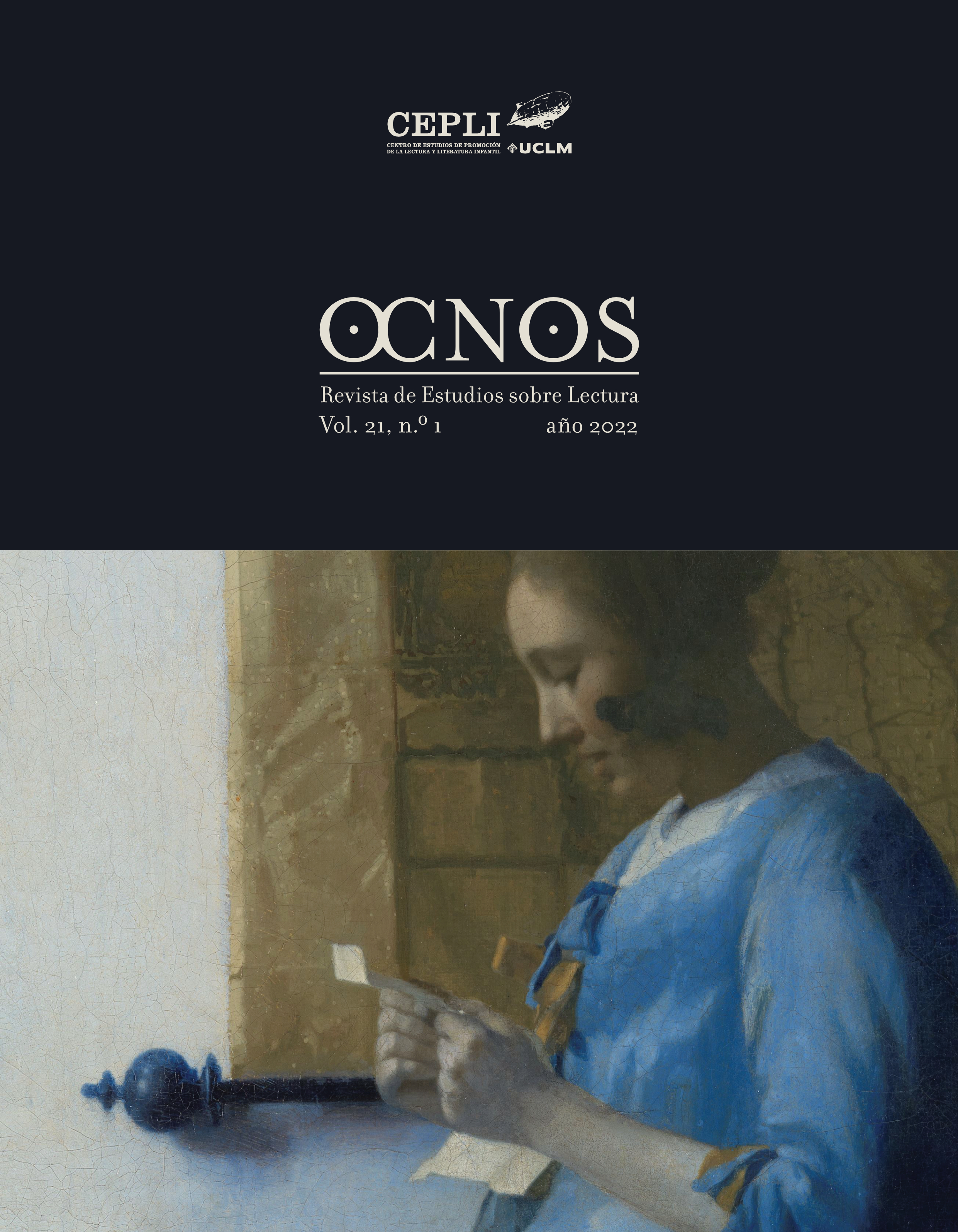Introducción
Los álbumes y cómics sin palabras usan exclusivamente los recursos del lenguaje visual para explicar historias. En consecuencia, el proceso de lectura de estas modalidades de libro consiste en descifrar los signos visuales que los componen. Arizpe (2011), resumiendo los trabajos de Nodelman (1988), Rowe (1996), Nières-Chevrel (2010) y Beckett (2012), lista las principales competencias que debe tener un lector de álbumes sin palabras. Entre ellas, dice que el lector debe buscar en su bagaje personal los recursos para descifrar los signos y dar sentido a lo que está viendo. Para ello, debe estar dispuesto a llenar los vacíos iconotextuales usando sus conocimientos experimentales e intericónicos.
La intericonicidad es el proceso de creación de una imagen a partir de la apelación, adopción o transformación de otra imagen. Sería el equivalente a la intertextualidad, término desarrollado por Genette (1989), pero con formas icónicas. Siguiendo con esa traslación, el hipotexto u obra original se denominaría hipoimagen y el hipertexto u obra final sería la hiperimagen. Aunque hay otros vocablos para denominar este proceso (interpictorialidad, intervisualidad, transpictorialidad, etc), nos decantamos por usar el término «intericonicidad» y calificamos las imágenes como intericónicas cuando en ellas pueden reconocerse objetos o sujetos pertenecientes al ámbito de la cultura visual.
Zuschlag (2006) sostiene que el término intericonicidad apareció por primera vez en el simposio “Text und Bild, Bild und Text” de 1988 y que la primera documentación de su uso data del 1997, en la conferencia de Bleyl titulada Interikonizität bei Joseph Beuys. Zuschlag señala que hay muchos términos que describen la relación entre obras de arte: réplica, copia, variación, versión, reproducción, cita, paráfrasis, parodia, imitación, pastiche, alusión, influencia, plagio, falsificación, homenaje, etc. Destaca también que el estudio de este fenómeno es de enorme trascendencia en la historia del arte y que, a pesar de ser uno de los intereses predilectos de los historiadores del arte, ni las definiciones, ni su uso están unificadas.
En el presente artículo identificaremos los conocimientos intericónicos que necesita el lector de álbumes y cómics sin palabras para conseguir una lectura completa. Para ello, después de presentar una clasificación de las imágenes intericónicas, analizaremos cómo las representaciones gráficas de mobiliario, electrodomésticos y objetos de decoración que aparecen en las habitaciones de álbumes y cómics sin palabras pueden ser un buen mecanismo para caracterizar los personajes. Para finalizar, se presenta un pequeño experimento de lectura de imágenes en el que se pretendía corroborar que, si el lector no había visto nunca los objetos representados, estos eran completamente invisibles.
Una aproximación a las imágenes intericónicas en los libros sin palabras
En un trabajo anterior (Bosch, 2015), se clasificaron las imágenes intericónicas según los siguientes criterios: autor, naturaleza, amplitud y grado de fidelidad (pp. 369-378) (tabla 1).
Tabla 1
Clasificación de las imágenes intericónicas
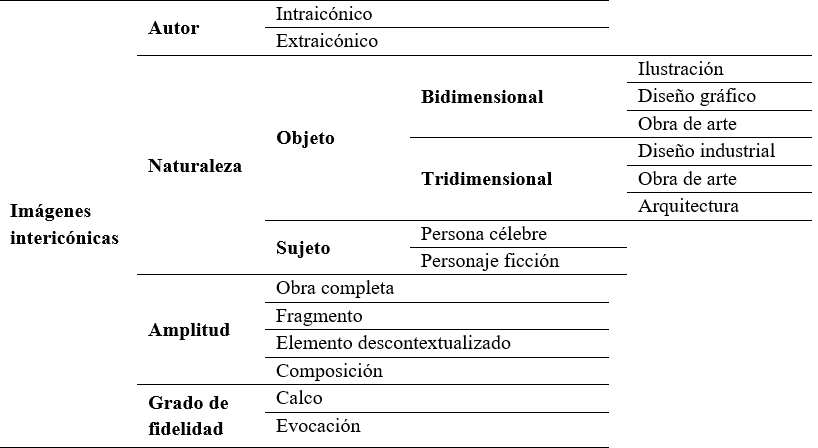
En referencia al autor de la hipoimagen, pueden distinguirse dos tipos: intraiconicidad y extraiconicidad. Las imágenes intraicónicas son aquellas realizadas por el mismo autor. En el ámbito de la ilustración, el autor hace referencias gráficas a otras obras suyas. Podría decirse que son «guiños» hacia sus admiradores más fieles. Las etiquetas pegadas en un baúl que aparecen en Rainstorm (Lehman, 2007) hacen alusión a otras obras de la autora: en una se aprecia la torre de uno de los laberintos en los que entra el protagonista de Museum Trip (2006), en otra aparece la cubierta de El libro rojo (2013), y en otra, el tren de Trainstop (2008). Las imágenes extraicónicas son aquellas en que la hipoimagen pertenece a otro autor (ilustrador, artista, diseñador, publicista, cineasta, etc). Un ejemplo sería el libro La croûte (Moundlic y Tallec, 2009) tirado en la desordenada habitación de la protagonista del álbum El extraordinario viaje de Prudence (Gastaut, 2011).
Según la naturaleza de la hipoimagen distinguimos entre objetos (bidimensionales o tridimensionales) y sujetos (personas célebres o personajes de ficción). Los objetos bidimensionales pueden ser ilustraciones, piezas de diseño gráfico y obras de arte. Un ejemplo de imagen intericónica del ámbito del diseño podría ser Johny Walker, el caminante de la marca de whisky creado por Browne (1908), que pasea por la campiña en El viaje de Anno III (Anno, 1982). Como ejemplo de imagen bidimensional intericónica basada en una obra de arte, destacamos Alt vi ikke vet (Roskifte, 2003) donde se ve en un edificio el famoso cartel con el luchador André the Giant del artista urbano Obey.
Si las imágenes representan objetos tridimensionales, estos pueden ser productos de diseño industrial, obras de arte o construcciones arquitectónicas. Como productos industriales encontramos objetos emblemáticos de todo tipo: aparatos electrónicos, juguetes, muebles, automóviles, etc. Por ejemplo, es perfectamente reconocible el Chevrolet Bel Air (1956) rosa y verde en El papagayo del señor Hulot (Merveille, 2012). Un ejemplo de obra de arte tridimensional sería el ready-made de Duchamp (1913) Roue de bicyclette en Le colis rouge (Perrin, 2007). Como ejemplo de obra arquitectónica podemos señalar la forma del terrado del edificio de Re-zoom (Banyai, 1995) inspirado en La Villa Savoye de Le Corbussier (1931).
Si la imagen representa un sujeto, este puede ser una persona célebre o un personaje de ficción. Celebridades del mundo del arte, la política, la ciencia, la filosofía... aparecen en El viaje de Anno III (Anno, 1982) donde, por ejemplo, vemos a los Beatles tocando en la calle. Referencias a personajes de ficción serían el póster de Charlot en El hombre de la flor (Ludy, 2006) y el dibujo animado Felix The Cat impreso en una camiseta de Re-Zoom (Banyai, 1999).
Respecto a la amplitud de la hipoimagen (Hoster y Lobato, 2012), es decir, cuando se toma como base la proporción entre ilustración y referente, pueden distinguirse cuatro tipos: obra completa, fragmento, elemento descontextualizado e imágenes que imitan la estructura compositiva. Un ejemplo de obra completa o rescate íntegro de la hipoimagen, podrían ser las cubiertas de libros de la biblioteca del centro cultural del álbum coral El libro de la noche (Berner, 2009), entre los que puede identificarse Por la noche (Erlbruch, 2001). Como ejemplo de rescate parcial destacamos una escena de Museum Trip (2006) donde el encuadre solo permite ver la parte inferior de diversas pinturas: El cumpleaños de Chagall (1915); un autorretrato de Van Gogh (1889); Is There Not an Invisible World de Redon (1887); y Los flamencos de Rosseau (1907). Como ejemplo del uso de elementos descontextualizados de la hipoimagen, destacamos Le colis rouge (Perrin, 2007), donde se identifican fragmentos de Carnival of Harlequin de Miró (1924-1925) y La Gerbe de Matisse (1952), que han sido extraídos de su fondo original y esparcidos por la escena. Un ejemplo muy ilustrativo de uso de la misma estructura compositiva de la hipoimagen lo encontramos en Mi globo paseando por Nueva York, yo en el Metropolitan Museo (Preiss Weitzman y Preiss Glasser, 2000). Este cómic explica dos historias paralelas: la visita de una niña con su abuela al museo y los intentos del portero de recuperar el globo de la niña que ha escapado volando. Las escenas urbanas «imitan» las obras de arte que admiran abuela y niña. Así, por ejemplo, vemos el parecido entre un cuidador de focas y la estatua Perseo triunfante de Canova (1806).
Respecto al grado de fidelidad de la hiperimagen en referencia a la hipoimagen (Hoster y Lobato, 2012) puede distinguirse entre imagen copiada o calcada y evocada. En las imágenes calcadas la hiperimagen es más o menos fiel a la hipoimagen. Puede tratarse de una reproducción fotográfica, como en el ya citado cómic o ser una copia del ilustrador, como las «imitaciones» de obras de Munch, Picasso, Hopper y otros artistas en Arte con pastel (Tjong Khing, 2018). Un ejemplo de evocación o reelaboración de la hipoimagen, lo encontramos en Le colis rouge (Perrin, 2007), con la simplificación de la escultura Halebardier de Calder (1971).
Como ha podido comprobarse en esta clasificación, hay muchos tipos de imágenes intericónicas y muchas maneras de aludir a las hipoimágenes. En las narrativas sin palabras, al no haber texto que dé pistas de esas relaciones intertextuales, el peso de la identificación de las hipoimágenes y la consecuente interpretación recae en el lector.
Objetos y mobiliario en álbumes y cómics nos hablan de los personajes
En los álbumes y cómics sin palabras todos los elementos representados pueden ser susceptibles de aportar información. La escenografía, el atrezzo, la caracterización y vestuario pueden usarse con fines narrativos y dar pistas al lector de cómo son los personajes. De hecho, los ilustradores no hacen otra cosa que imitar la vida. ¿O acaso nuestra forma de vestir y de peinarnos y los muebles y objetos de nuestro hogar no hablan de cómo somos?
Esto es evidente en los álbumes documentales, aquellas narraciones en las que interesa más el showing que el narrar telling (Nikolajeva y Scott, 2006). Pero no solo en las obras documentales (crónicas y panorámicas) son importantes los contextos y escenarios (Bosch, 2015, pp. 224-226). También pueden serlo en las de ficción. Si el ilustrador se lo propone, mobiliario, objetos y elementos decorativos pueden hablarnos de la edad, aficiones, nivel socioeconómico o procedencia de los personajes, como así lo demuestran estos ejemplos:
Los objetos nos pueden hablar de la edad de los personajes. En el álbum crónica Window (Baker, 2002), que muestra cómo se urbaniza un entorno natural a lo largo de la vida de un joven, la autora deja pistas en el alféizar de la ventana para que el lector sepa la edad de Sam en cada escena.
Los objetos nos hablan de las aficiones de los personajes. En El viaje de Max (David y Caudry, 2008), el mobiliario sencillo, práctico y cómodo de la cabaña del protagonista es señal de su vida austera. Libros sobre viajes, mapas y objetos, como el globo terráqueo y la brújula, nos hablan del interés de Max por los viajes. Y los libros sobre fenómenos atmosféricos, además de los carteles de un globo aerostático, de un hombre alado y de Hermes, así como el telescopio y los modelos de un zepelín y una avioneta, nos indican su pasión por la aeronáutica. Todos estos objetos nos dan pistas para conocer el transporte escogido por Max para su viaje.
Los objetos nos hablan del nivel económico de los personajes. El protagonista de Rainstorm (Lehman, 2007) vive en un gran caserón. Gracias al mobiliario clásico, los retratos de las paredes, las esculturas y otros objetos valiosos, como armaduras, vitrinas y relojes de pared, sabemos que ese niño solitario que se aburre en un día de lluvia es muy rico.
Los objetos nos hablan del origen de los personajes. En Doña Elba (Díaz Prieto, 2015) se narra la historia de una señora que sufre la invasión en su hogar de unos dragoncillos blancos. Viendo el mobiliario y la decoración de la casa podemos asegurar que la protagonista vive en Buenos Aires. Uno de los indicios más claros es la nevera SIAM, un electrodoméstico creado en 1935 que tuvo un gran éxito de ventas en Argentina llegando a convertirse en un icono nacional. Otra señal es la estatuilla de la Virgen de Luján, patrona de Argentina, que está encima del televisor y de la nevera y en el aparador del comedor.
Estos ejemplos demuestran que los signos que utilizan los autores solo pueden descifrarse si el lector ha visto antes esos objetos, es decir, si tiene un bagaje suficientemente amplio para poder interpretar estas señales.
Metodología
¿Hasta qué punto pueden hablar los objetos de las personas que los poseen? ¿Y hasta qué punto pueden los lectores interpretar lo que dicen esos objetos? Para responder estas preguntas realizamos un pequeño juego-experimento de lectura de imágenes que hemos titulado, ¿Quién vive aquí?, que consistió en que personas de diferentes edades y procedencias intentaran descubrir quiénes podían ser los habitantes de una casa viendo solamente el mobiliario y la decoración de las estancias.
Para llevar a cabo el experimento usamos el álbum Unser haus! de Antje Von Stemm (2005). El libro tiene las páginas seccionadas y gracias a la encuadernación con una doble espiral y apertura french door, se pueden ir pasando a discreción las diferentes páginas en las que están representadas las habitaciones de seis apartamentos de un mismo edificio (figura 1). La labor de diseñadora de interiores que realiza la autora es esencial para que el lector conozca a los habitantes de los seis pisos. De hecho, en la cubierta posterior puede leerse que los vecinos son tan diferentes como lo son sus viviendas. Y así es.
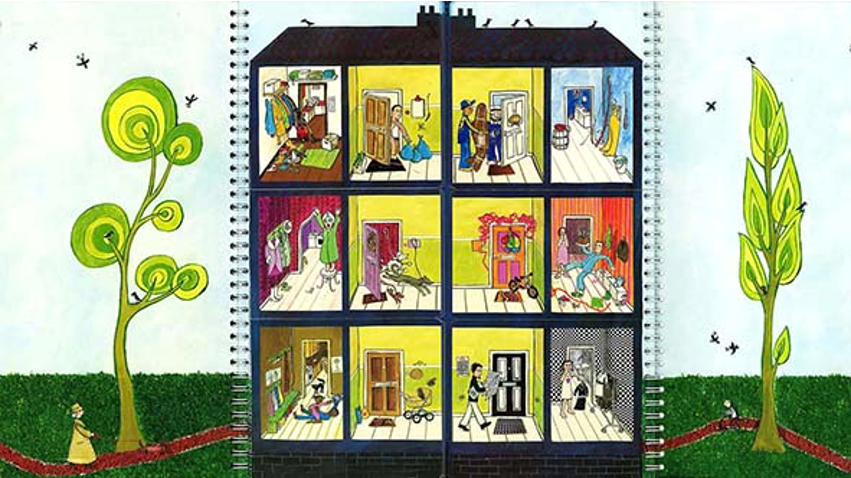 Figura 1
Imagen principal del álbum Unser Haus!
Figura 1
Imagen principal del álbum Unser Haus!
Ya desde el inicio del libro se evidencian estas diferencias por la variedad de las entradas de las viviendas. Solo viendo los rellanos el lector puede hacerse una primera idea de quién vive en cada apartamento. Por ejemplo, en el ático, una caja de envases de bebida vacíos, bolsas de basura acumulándose y un felpudo con la imagen del disco de Pink Floyd, Dark Side of the Moon, nos informan de la forma de vida de sus inquilinos y de sus gustos musicales. Pero solo aquel que sepa leer esas imágenes, esas referencias, tendrá una experiencia de lectura completa. Si el lector nunca ha visto esa carátula, solo verá un prisma que descompone la luz en un arco iris. Si no se ha visto antes, es imposible «verlo». No puede verse, porque no se conoce.
Unser haus! es ideal para tratar la intericonicidad por su multitud de imágenes intericónicas. Imágenes intraicónicas, como los libros de la propia autora que están tirados por el suelo en los pisos con niños: Nightmare Hotel (1997) y Nightmare Cafe (1998) escritos por Henry. También hay extraicónicas, como el libro Al señor Zorro le gustan los libros, de Biermann (2008), tirado en el suelo de otro dormitorio infantil. Hay también piezas de diseño gráfico (la marca Apple en un ordenador del piso de una pareja de diseñadores) y de pinturas (Composition with Red. Yellow, Blue and Black de Piet Mondrian, 1921), así como productos industriales conocidos (la lámpara Arco de Castiglioni (1962), la butaca Egg de Jacobsen (1958), una silla similar a la MVR3 de Van der Rohe (1930), el reloj de pared OJ Nomon de Reina, y la lámpara Smila Luna y el peluche Snake Alleby, ambos comercializados por Ikea). También hay personalidades célebres (el comandante Ché Guevara aparece en un póster en una de las cocinas) y personajes de ficción (Mickey Mouse de Disney (1928) en la pantalla de un televisor).
Procedimiento
Para llevar a cabo el experimento se escanearon todas las escenas del libro y se borraron digitalmente los personajes (figura 2).
 Figura 2
Ejemplo de estancia en la que se han borrado los personajes de un apartamento de “Unser Haus!” y tal y como aparece en el libro.
Figura 2
Ejemplo de estancia en la que se han borrado los personajes de un apartamento de “Unser Haus!” y tal y como aparece en el libro.
En una hoja de tamaño DIN-A3 se agruparon las estancias de un mismo apartamento (manteniendo el tamaño original de las ilustraciones). Así, en seis hojas de papel, estaban a la vista las estancias de cada piso, ahora totalmente vacías (figura 3).
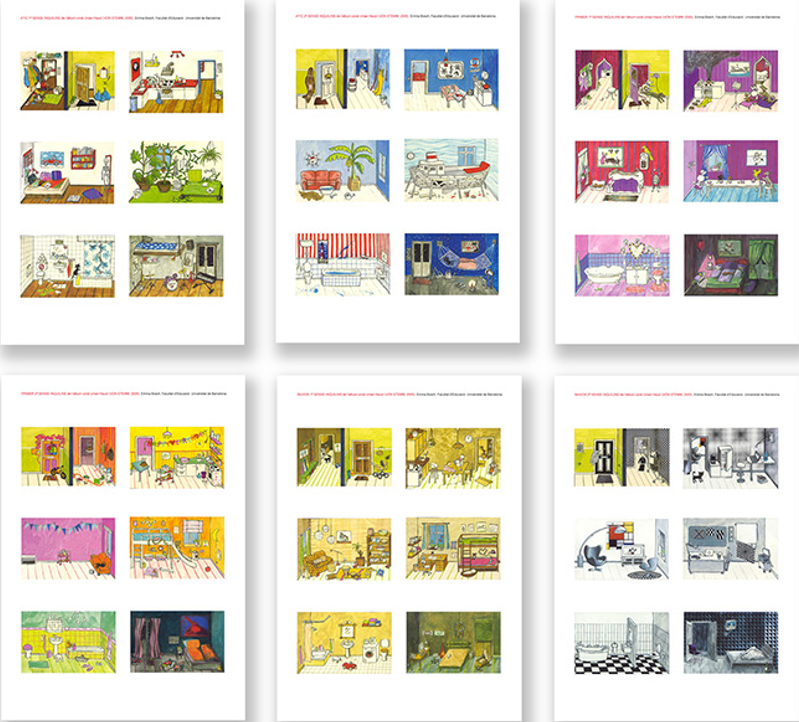 Figura 3
Estancias vacías de los seis apartamentos de Unser Haus!
Figura 3
Estancias vacías de los seis apartamentos de Unser Haus!
Participantes
Participaron en este juego-experimento 17 personas, seis niños y niñas de entre 6 a 11 años (tabla 2), cinco jóvenes entre 15 y 21 años (tabla 3) y seis adultos entre 47 y 79 años (tabla 4). De ellos, diez habían nacido y residen en Barcelona, una había nacido en Alemania y reside en Barcelona y cinco eran alemanes. Todos pertenecen a una clase social media-alta y tienen alguna relación con las artes visuales, la medicina y la educación. Las conexiones familiares o de amistad con los participantes permitieron contextualizar y corroborar sus respuestas. Como puede comprobarse por el número de individuos y su idiosincrasia, se trata de un pequeño experimento sin pretensiones estadísticas.
Tabla 2
Niños y niñas participantes en el juego-experimento ¿Quién vive aquí?

Nota:El alias está formado de la inicial del nombre más la letra F o M (según el género) y la cifra de su edad.
Tabla 3
Jóvenes participantes en el juego-experimento

Tabla 4
Adultos participantes en el juego-experimento
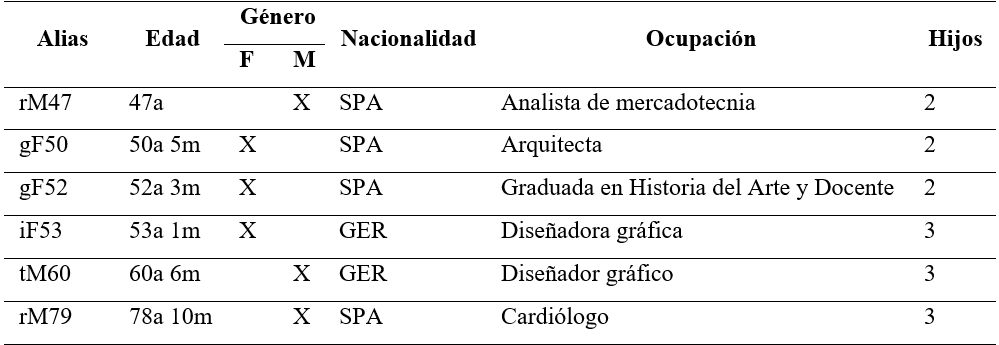
Para comparar las estrategias de lectura, se mostraron los pisos siempre en el mismo orden. Las instrucciones eran sencillas, los lectores debían decir quiénes vivían en cada casa, concretando edad, sexo, profesión y aficiones de sus habitantes. Mientras observaban las imágenes debían señalar las «pruebas» que argumentaban sus opiniones. Al finalizar la lectura de cada apartamento, se les preguntaba si habían visto algunos de los objetos y dónde los habían visto. Las entrevistas se grabaron y se transcribieron para facilitar su posterior análisis.
 Figura 4
Algunos participantes del juego-experimento
Figura 4
Algunos participantes del juego-experimento
Resultados
Algunas notas sobre la lectura de objetos
Con esta sencilla prueba pudo demostrarse nuestra hipótesis: los objetos pueden hablar de los personajes, pero solo aquellos que los habían visto antes, podían verlos en las imágenes y, en consecuencia, leerlos. A continuación, comentaremos algunos de los resultados obtenidos.
¿Los objetos nos hablan de las profesiones y hobbies de los personajes? En el libro hay pistas para saber la profesión o aficiones de algunos personajes y los participantes en el experimento los identificaron con mayor o menor acierto. La más fácil fue la cantante de ópera ya que muchos reconocieron el atril con la partitura, los retratos de una señora cantando y las fotos de cantantes en un espejo (lF9/vM9/mM10/nM11/aF15/nM19/gF50/gF52/rM79). Solo dos lectores de menor edad no leyeron esos indicios (lF6/iF7). Cabe destacar que, según el bagaje del lector, se utilizaba un determinado vocabulario. Por ejemplo, en el piso de estudiantes, el esqueleto y los libros (especialmente el de anatomía) se leyeron como objetos que pertenecían a un estudiante de medicina (mM10/nF19/pF21/gF52/rM79), de fisioterapia (gF50), o a un científico (vM9). Los más jóvenes dijeron, simplemente, que «le gusta los esqueletos y leer» (iF7) o «el cuerpo humano y los libros» (mM11) o que «es una niña que estudia las calaveras» (lF6). Por otro lado, la multitud de plantas en una de las habitaciones hicieron decir que al inquilino le gustaban mucho las plantas (lF6/iF7), la jardinería (aF15), la naturaleza (nM11/nF19/rM79), que era un botánico (vM9), un agrónomo (gF50), un activista de Greenpeace o biólogo (gF52). Pero, solo cuatro vieron el gorro, el libro de cocina y la caja de cuchillos (nM11/mM10/nF19/pF21) que definían su profesión real de cocinero. El no relacionar estos signos con un cocinero, hicieron que la caja de cuchillos y el libro con la imagen de una zanahoria se leyeran como una caja de herramientas y un libro de cultivos (rM79) y si se creyó que era un botánico se leyeran como instrumentos de laboratorio y una caja de semillas (gF52). Hubo más imágenes que confundieron a los lectores. Por ejemplo, uno de los vestidos de una inquilina se interpretó como un uniforme de policía (vM9) o un rollo de papel de regalo, tijeras e hilo en una mesa se interpretaron como telas, por lo que se dedujo que a los habitantes les gustaba coser (iF7/mM10/nM11/nF19/gF52) o que ahí vivía un sastre (vM9). Solo una persona interpretó bien la escena diciendo que se estaba empaquetando un regalo (iF53).
¿Los objetos hablan de la edad? Cuna, trona, cochecito, biberón… fueron signos evidentes de que en un piso vivía un bebé; y juguetes, literas, dibujos infantiles, desorden… de que vivían niños. Esas señales fueron fácilmente reconocibles por todos los participantes, pero fue más difícil concretar la edad. Aunque hubiera pistas de la edad de un personaje (una tarta de cumpleaños con tres velas) (lF6/vM9/mM10), hubo quien contó los globos de la entrada: 7 años (vM9). O quien, a pesar de contar las tres velas, no le cuadraba que la niña durmiera en una cama tan alta con esa edad (aF15/gF50). Más difícil fue concretar la edad de los habitantes de un piso compartido. La horquilla oscilaba entre los 19 y los 30 años. Se los consideró con el genérico «jóvenes», entre 19 y 22 años (gF52), entre 20 y 25 (nF19), o simplemente se definieron como mayores de edad porque tenían un coche (RrM79). Hubo quien argumentó que unos estudiantes con un póster de Ché Guevara y con un felpudo de Pink Floyd no podían ser jóvenes, y quizás tampoco estudiantes, así que les asignaron unos 30 años (gF50).
¿Los objetos hablan de la procedencia de los personajes? Solo se hizo referencia a la nacionalidad de dos de los inquilinos. En uno no hubo consenso y en el otro la respuesta fue muy ambigua. Por los cuadros, los abrigos y los marcos de la puerta de la vivienda de la cantante de ópera se la identificó como rusa (nF19/gF50/iF53) u originaria del Báltico (gF52). Las alfombras y babuchas también fueron leídas como pistas (rM47/gF52) pero no se concretó la nacionalidad. Por el sofá, el teléfono, el papel pintado y el sombrero se identificó como británica o francesa (lM18/pF21). Y hay quien se aventuró a decir que era griega porque se trataba de Maria Callas (tM60). Menos concreta fue la lectura de los tambores, la lámpara, la cama doble y el estampado de jirafa del sofá, para decir que la familia que ahí vivía había visitado África (gF50), tenía influencias de la cultura africana (kM15) o eran de origen africano (aF15/nF19/gF52). Sin embargo, hubo quien no vio ningún indicio del origen africano de los objetos (lF6/iF7/vM9/mM10/nM10), ni aunque se le preguntara expresamente por ello (rM79).
¿Los objetos nos hablan del carácter y la personalidad? En referencia a la cantante de ópera, se dijo que «es muy pija» porque pone los animales a comer en la mesa y tiene alfombras en el baño y el espejo en forma de corazón» (aF15). Que era «un poco excéntrica» porque comía en la mesa con los animales y dormía con ellos (gF50). O que era muy presumida porque tenía un caniche y «el color rosa dice que es coqueta» (nF19). Lo que para algunos lectores era simplemente una persona «despistada» porque había olvidado el cazo en el fuego (nM11) para otros, era señal de que tenía despistes porque estaba desarrollando «alzheimer o una demencia senil» (gF50). Fue habitual hacer referencia al orden de las estancias. Se calificó como desordenados a los estudiantes que compartían piso, por tener los platos por fregar, los zapatos desparejados por el suelo, las bolsas de basura acumulándose (lF9/nM11/pF21/gF52). De hecho, hubo quien dijo que en esa vivienda las habitaciones individuales estaban «impecables» y los espacios comunes estaban muy desordenados (nM19/gF52/iF53).
Solo vemos lo que hemos visto y vivido
Hay imágenes universales que traspasan todas las fronteras (sexo, edad, origen…). En el experimento fueron Mickey Mouse y el ordenador Macintosh de Apple. Curiosamente el atrapasueños fue uno de los objetos más conocidos (If7), la mayoría tenían uno en sus hogares (aF15/kM15/lM18/nF19/rM47/gF50/gF52/iF53/Tm60) e, incluso, hubo quien había hecho uno ellos mismos (lF6/vM9/nM10/mM11). Solo el lector de mayor edad ni lo vio ni preguntó por esa imagen (rM79). Posteriormente afirmó que nunca antes había visto alguno.
Lo que no se ha visto antes es invisible, ni se ve, ni llama la atención, ni se pregunta por ello. Por ejemplo, si no se ha estado nunca en un piso compartido, no se verá el cartel para repartir las tareas (lF6/iF7/aF15); o, al contrario, si se ha vivido así, además de verlo rápidamente, puede saberse que uno de los estudiantes realiza más tareas que los otros (gF52/iF53). Por otro lado, no haber visto una casa sin sala de estar (lF6) o no haber estado en un piso de estudiantes (iF7) hará hablar a los lectores siempre en términos de familia (padre, madre, hijos…). Tampoco es concebible para algunos lectores que un dormitorio de adultos tenga muñecos, libros ilustrados y ropa por el suelo (rM79) por lo que se llegó a decir que ahí dormían un adulto y un niño (gF52/tM60). Además, si en la cama doble hay dos edredones, se reafirma la idea de que no duerme una pareja sentimental (nF19/gF52).
Solo los lectores de mayor edad nombraron al comandante Ché Guevara y dedujeron la afiliación izquierdista de sus habitantes (rM47/gF50/gF52/rM79). La única menor que dijo conocerlo, falló en su interpretación: «es un rockero porque mi padre lo tiene y a él le gusta el rock» (iF7). Los demás participantes ni se interesaron por saber quién era.
Solo los lectores alemanes identificaron rápidamente el cazo bocabajo en el suelo de una de las habitaciones con el juego topfschlagen que suele jugarse en las fiestas de aniversario infantiles (lF9/lM18/pF21/iF53/tM60). Hubo una participante que al verlo dijo que eso no pintaba nada ahí (nF19). El resto, ni lo nombró. Los alemanes y aquellos que tenían alguna relación con Alemania (nF19/rM47/gF52/rM79) también reconocieron al famosísimo personaje de dibujos animados de Die Sendung mit der Maus. Y solo los alemanes nombraron el coche de juguete Bobby Car. No ser alemán, por el contrario, comportó errores de interpretación. Por ejemplo, en su búsqueda de pistas para confirmar la presencia de un gato, una lectora (gF52) dijo que un paquete de jabón encima de la lavadora era comida para felinos. Al comprobar que había una rana dibujada, rectificó diciendo que era un catálogo de imágenes de plástico para ver en la bañera, aunque no hubiera bañera alguna. Necesitaba dar significado a un objeto que los alemanes identificaron al momento como el jabón ecológico para ropa Frosch (iF53).
Los expertos pudieron detectar situaciones que para los demás pasaron desapercibidas. Ver con ojos de arquitecta conllevó a detectar «fallos graves» de representación y, al ver una lámpara demasiado cerca de una bañera, exclamar: «¡No sigue la normativa!» o «¡A este lavabo le falta la cisterna!» (gF50). Ser maestra de música permitió nombrar todos los instrumentos de percusión de una escena: maracas, djembé, bongos, güiro y pandereta (gF52) donde los demás solo veían «tambores» (lF6/iF7/vM9/mM10/nM11/aF15/kM15/nF19/gF50/rM79). En este sentido, al no haber visto nunca un güiro, una joven lectora lo confundió con una barra de pan y, aunque no tuviera sentido que estuviera en el suelo, dijo «les gusta la música y el pan» (lF6). Ser licenciada en historia del arte permitió identificar el movimiento artístico Op Art (gF52). Respecto al bagaje artístico de los participantes, solo tres de los más jóvenes dijeron haber visto alguna vez la pintura de Mondrian (iF7/nM10/mM11), hubo quien confundió al autor de la obra con Kandinsky (tM60) o con Klee (rM79) y solo cuatro de los mayores conocieron el nombre del artista (lM18/nF19/gF50/gF52). Uno de ellos añadió que Mondrian era un artista holandés de los años 20 que se enmarcaba en el movimiento «De Stijl». Se trataba de un joven que deseaba cursar la carrera de Historia del Arte (lM18).
Las fuentes donde dijeron los participantes en que se habían basado fueron, además del propio hogar, casas de familiares y amigos, tiendas, hoteles, consultas de médicos… pero también películas, catálogos de muebles en internet o en Instagram. Sin embargo, hay que tener presente que algunas de las respuestas en referencia a las fuentes no fueron fiables. Por ejemplo, estando una lámpara muy similar a la lámpara Arco de Castiglioni en la misma habitación en la que se hizo la entrevista, hubo quien dijo que no la había visto nunca (lF6/gF52); o que una niña (lF6) dijera que uno de los libros ilustrados que aparecen tirados en el suelo de una de las habitaciones infantiles lo tenía en el apartamento de la playa de sus abuelos y el abuelo dijera que no lo había visto nunca cuando nos consta que lo había leído a su nieta (rM79).
Algunas notas sobre los estereotipos
La mayoría de los lectores designaron lámparas y espejos en forma de corazón, muñecas, cocinitas, cortinas, alfombras peludas, libros, gatos y, en definitiva, las cosas rosas como objetos «femeninos» (lF6/iF7/lF9/mM10/aF15/kM15/lM18 /nF19/gF50/gF52/rM79). Y como objetos «masculinos»: los dibujos de animales, instrumentos musicales, coches de juguete y bicicletas (lF6/iF7/nF19/rM47), además de todo lo verde (iF7/lF9/kM15/nF19/gF50/gF52). De hecho, una de las lectoras de menor edad afirmó categóricamente: «Hay cosas de niños y cosas de niñas, hay colores de niñas y colores de niños» (lF6). Pero, unas cuantas lectoras se percataron de que su interpretación estaba impregnada de prejuicios y reflexionaron sobre cómo se usaban esos objetos en el mundo real y, en consecuencia, cómo los había trasladado la ilustradora al libro (aF15/nF19/pF21/gF50 /gF52). «No diremos que porqué haya una cocinita tiene que ser una niña» exclamó una participante (gF52) que se resistía a leer las imágenes según ese prisma mientras buscaba pistas en un dormitorio infantil. Por ello, para dejar claro que no se compartía esa mirada, muchas usaron antes de emitir sus juicios la siguiente fórmula «siguiendo los estereotipos, diríamos que…» (aF15/nF19/pF21/gF50/gF52). Además, hubo quien se alegró cuando comprobó que la ilustradora había «roto algunos esquemas» como asignar a un chico una batería rosa y un edredón estampado con nubes y poner en el wc una señal de prohibido orinar de pie en un apartamento en el que solo viven varones (nF19).
Algunas notas sobre los procesos de lectura de imagen
Entre los participantes del experimento pudieron detectarse estilos diversos de lectura de imágenes. Esas diferencias no se debieron ni a la edad ni a la procedencia. Hubo lectores muy sistemáticos que siguieron el orden de lectura occidental de arriba abajo (iF7/nF19/rM79) e, incluso, de abajo hacia arriba (gF52). Estos rastreaban una a una las habitaciones y no pasaban a la siguiente hasta que no habían enumerado todo lo que veían. Por el contrario, hubo quien echaba una ojeada rápida y hablaba a partir de los objetos más evidentes (vM9/kM15/lM18/pF21/gF50/iF53/tM60). Unos entendieron rápidamente la dinámica del juego y pronto usaron fórmulas similares a «sé que vive una persona de tales características porque veo este objeto» (iF7/nF19/iF53). Otros, más reservados, solo hablaron cuando se les preguntó y contestaban escuetamente (lF9/vM9/mM10). Pero también hubo quien conectó las imágenes con experiencias y anécdotas personales (iF7/tM60). Unos pocos, ya avanzada la actividad, empezaron a inventar historias a partir de las imágenes (iF7/gF52/tM60/rM79), por lo que se les recordó que debían basar sus interpretaciones en pruebas objetivas.
Cuando un lector descubría que un objeto le había dado información que él creía fidedigna, lo buscaba en los demás apartamentos. Por ello, hubo quien basó sus primeras hipótesis estudiando los abrigos de los vestíbulos (lF6/iF7/rM79) o los cuadros de las paredes (lF9/vM9/nM11). Pero, a veces, esas pistas inducían a error. Por ejemplo, en el piso donde viven tres estudiantes hay siete abrigos, o la cantante de ópera, que vive sola, tiene dos (nM11/gF52). Esas falsas interpretaciones podían despistar a los lectores. Por ejemplo, si se seguía la pista de los cuadros, la imagen de la cantante de ópera junto al pianista podía hacer creer que eran dos persones las que vivían en el apartamento (lF9/mM11/gF52/rM79).
Hubo quien olvidó que los personajes habían sido borrados y se extrañaban de ver objetos volando, como pasteles (aF15) y periódicos (nF19/gF50/rM79), o ver bultos en las camas (iF7).
Algunas notas sobre el experimento y el material utilizado
Algunos calificaron la actividad de divertida (iF7/nF19/iF53), emocionante (lF9) y sorprendente (gF52). Respecto al nivel de dificultad, hubo diversidad de opiniones: desde un poco difícil (iF7/lF9/mM11), regular (lF9), bastante difícil (vM9) a muy difícil (gF52). Y hay quien dijo que la dificultad dependía del piso (nF19). Hubo quienes se interesaron por saber cómo se habían borrado los personajes (iF7/gF52) y se admiró el borrado y la reconstrucción de los escenarios (iF7/nF19/gF52/iF53/tM60). Al ver el libro, algunos quisieron comparar las imágenes con las estancias vacías (iF7/mM10/aF15) y repasaron los pisos comentando sus aciertos y errores (mM10/aF15/gF-50/gF52). El libro sorprendió y gustó tanto a pequeños como a mayores, sobre todo por la interconexión de las historias (aF15/mF19/gF52/iF53). Y hubo quien opinó que «no porque parezca un libro para niños es solo para niños» (pF21).
Conclusiones
Hemos podido comprobar con este sencillo experimento que el significado de una imagen intericónica reside en sus relaciones con otros textos o formas culturales. En las narrativas sin palabras no hay información escrita de esas relaciones, por lo que solamente habiendo visto previamente determinados objetos, piezas de mobiliario, obras de arte, etc. es posible reconocerlos. Conocer esas referencias ayuda a entender mejor a los personajes y sus historias. Reconocer esas relaciones es fuente de placer y, lo que es más importante, nos permite apreciar mejor la riqueza de nuestro entorno cultural. En palabras de Salisbury y Styles (2012), “Recognising intericonic images gives readers great pleasure. To develop this skill the role of the mediator is essential in helping readers to recognise the hyperimages and foster knowledge of the hypoimage, thus increasing the cultural awareness of less expert readers” (p. 189).
En esta línea, es importante que los mediadores de libros sin palabras diseñen actividades para que los lectores lean las imágenes con más atención y se pregunten por aquellos signos que desconocen. Los participantes de este experimento reconocieron que ven las imágenes de los libros con demasiada rapidez. Muchos dijeron que con este juego habían descubierto que las «cosas» daban mucha información y que a partir de ahora se tomarían más tiempo para leer las ilustraciones. Mirar con detenimiento es un primer paso, imprescindible, para poder reconocer las imágenes y preguntarse por ellas si son desconocidas. El mediador debería despertar la curiosidad del lector por el mundo (visual) en el que vive y ayudarle a incrementar su bagaje haciéndole notar que no está viendo los signos que desconoce. La actividad ¿Quién vive aquí? cumple este propósito y puede ser fácilmente replicable usando otras obras intericónicas.
El experimento que aquí hemos presentado podría bien ser un piloto para desarrollar una investigación de mayor envergadura que podría llevarse a cabo con un equipo internacional formado por dos grupos de trabajo sitos en España y en Alemania con conocimientos tanto en Didáctica de la Educación Visual y Plástica como en Literatura Infantil. La muestra se ampliaría en número de individuos (niños y jóvenes y sus progenitores) teniendo en cuenta que edad y género estuvieran equilibrados. También sería conveniente seleccionar sujetos de diferentes niveles socio-económicos. Una muestra ampliada y diversa permitiría comparar las lecturas realizadas según diferentes parámetros y el posterior análisis adquiriría valor estadístico.
Conocer cuáles son las estrategias de lectura de imágenes de lectores de diferentes características facilitará la creación de proyectos efectivos de mediación en los que los lectores puedan activar su atención visual y despertar su interés por «conocer» la realidad que ha sido representada en aras de conocer mejor el mundo en que vivimos.
Antes hemos comentado que los ilustradores imitan la vida. Pero es emocionante ver cómo los libros ilustrados pueden reconectar al lector con la vida. Valga esta anécdota para ilustrarlo: días después de realizar la lectura, una de las niñas (lF9) jugó con una amiga a buscar pistas en las habitaciones de su casa para identificar juntas quiénes vivían ahí. La joven lectora reconectaba su experiencia lectora con la vida real.

